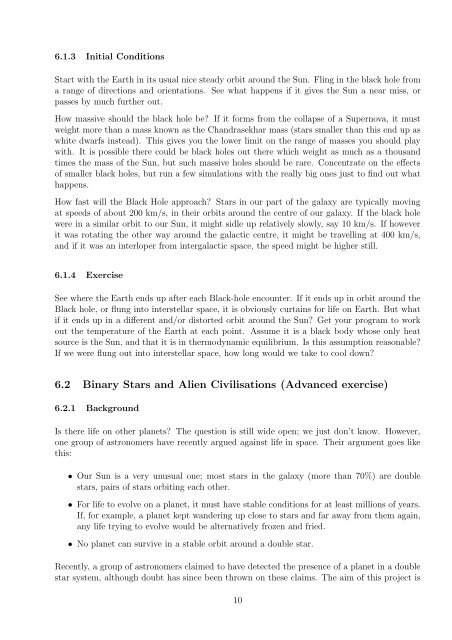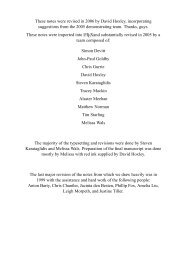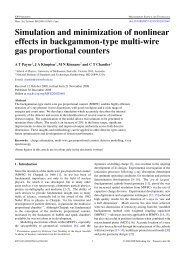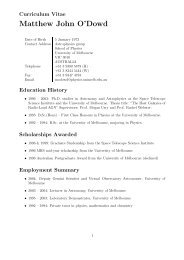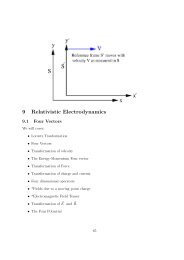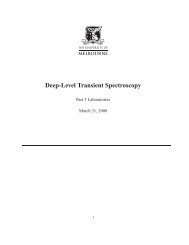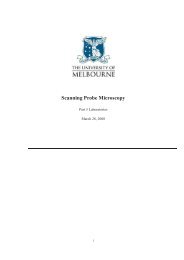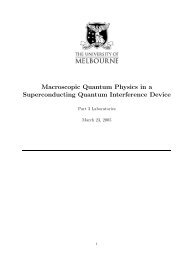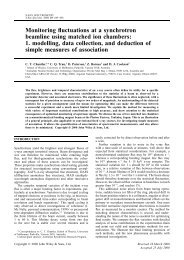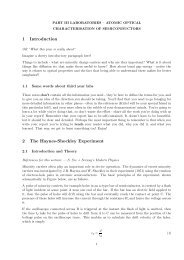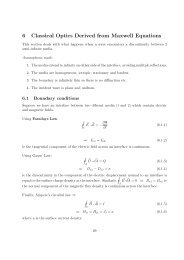Computational Astrophysics: N-Body Exercise
Computational Astrophysics: N-Body Exercise
Computational Astrophysics: N-Body Exercise
You also want an ePaper? Increase the reach of your titles
YUMPU automatically turns print PDFs into web optimized ePapers that Google loves.
6.1.3 Initial Conditions<br />
Start with the Earth in its usual nice steady orbit around the Sun. Fling in the black hole from<br />
a range of directions and orientations. See what happens if it gives the Sun a near miss, or<br />
passes by much further out.<br />
How massive should the black hole be? If it forms from the collapse of a Supernova, it must<br />
weight more than a mass known as the Chandrasekhar mass (stars smaller than this end up as<br />
white dwarfs instead). This gives you the lower limit on the range of masses you should play<br />
with. It is possible there could be black holes out there which weight as much as a thousand<br />
times the mass of the Sun, but such massive holes should be rare. Concentrate on the effects<br />
of smaller black holes, but run a few simulations with the really big ones just to find out what<br />
happens.<br />
How fast will the Black Hole approach? Stars in our part of the galaxy are typically moving<br />
at speeds of about 200 km/s, in their orbits around the centre of our galaxy. If the black hole<br />
were in a similar orbit to our Sun, it might sidle up relatively slowly, say 10 km/s. If however<br />
it was rotating the other way around the galactic centre, it might be travelling at 400 km/s,<br />
and if it was an interloper from intergalactic space, the speed might be higher still.<br />
6.1.4 <strong>Exercise</strong><br />
See where the Earth ends up after each Black-hole encounter. If it ends up in orbit around the<br />
Black hole, or flung into interstellar space, it is obviously curtains for life on Earth. But what<br />
if it ends up in a different and/or distorted orbit around the Sun? Get your program to work<br />
out the temperature of the Earth at each point. Assume it is a black body whose only heat<br />
source is the Sun, and that it is in thermodynamic equilibrium. Is this assumption reasonable?<br />
If we were flung out into interstellar space, how long would we take to cool down?<br />
6.2 Binary Stars and Alien Civilisations (Advanced exercise)<br />
6.2.1 Background<br />
Is there life on other planets? The question is still wide open; we just don’t know. However,<br />
one group of astronomers have recently argued against life in space. Their argument goes like<br />
this:<br />
• Our Sun is a very unusual one; most stars in the galaxy (more than 70%) are double<br />
stars, pairs of stars orbiting each other.<br />
• For life to evolve on a planet, it must have stable conditions for at least millions of years.<br />
If, for example, a planet kept wandering up close to stars and far away from them again,<br />
any life trying to evolve would be alternatively frozen and fried.<br />
• No planet can survive in a stable orbit around a double star.<br />
Recently, a group of astronomers claimed to have detected the presence of a planet in a double<br />
star system, although doubt has since been thrown on these claims. The aim of this project is<br />
10


